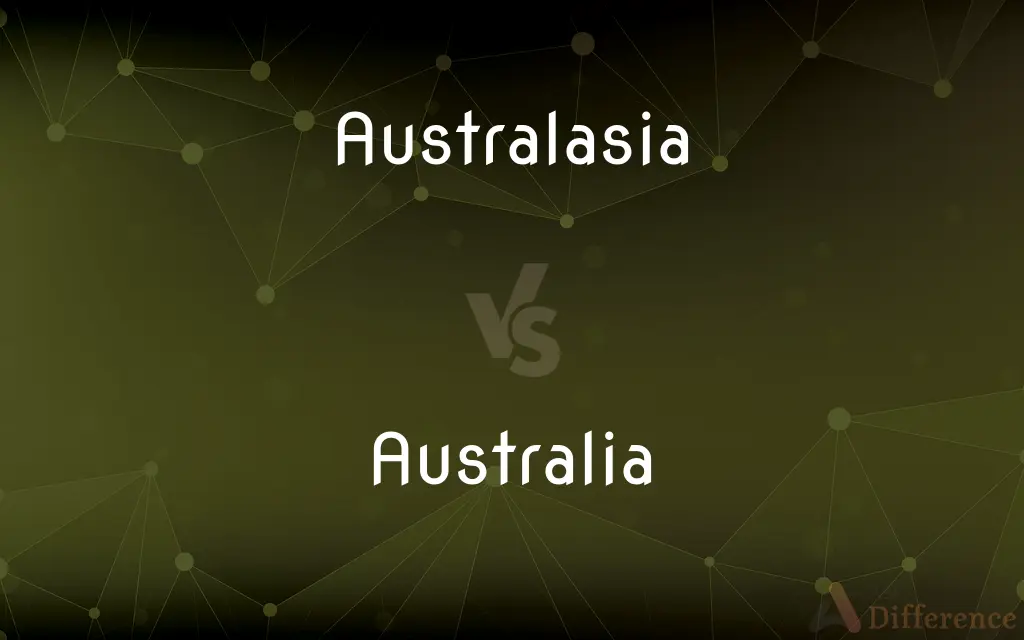Australasia vs. Australia — What's the Difference?
By Tayyaba Rehman & Fiza Rafique — Updated on April 3, 2024
Australasia is a region including Australia, New Zealand, and neighboring islands, while Australia refers specifically to the country and continent.

Difference Between Australasia and Australia
Table of Contents
ADVERTISEMENT
Key Differences
Australasia is a geographical term that encompasses not just the continent of Australia but also New Zealand and the islands of the southwestern Pacific Ocean. This broader regional perspective includes several countries and territories, highlighting a more inclusive area in both ecological and cultural terms. In contrast, Australia specifically refers to the country and continent, the world's smallest continent, situated in the Southern Hemisphere and known for its unique biodiversity, including many species that are found nowhere else on Earth.
The concept of Australasia helps in understanding ecological and biogeographical dynamics better by including New Zealand and the Pacific islands, areas with distinct ecosystems and species from Australia. This distinction is crucial for conservation efforts and ecological studies. Australia, on its own, boasts a diverse range of habitats, from coral reefs to desert landscapes, each with its unique flora and fauna. The inclusion of New Zealand and Pacific islands under Australasia adds a broader range of ecosystems, such as New Zealand's temperate forests and the Pacific islands' tropical climates.
From a cultural and historical perspective, Australasia encompasses the varied histories and cultures of its constituent countries and territories, including the indigenous cultures of Australia, the Maori of New Zealand, and the myriad cultures of the Pacific islands. Australia's culture, while distinct and rich on its own, represents only a part of the broader tapestry of traditions, languages, and histories that make up Australasia. This distinction emphasizes the diversity and complexity of human societies in this part of the world.
In terms of sports and political cooperation, Australasia sometimes functions as a combined entity in certain international forums and sporting events, reflecting a level of regional identity and collaboration. However, Australia, as a nation, has its distinct identity, policies, and international relations, participating globally in its right on various fronts including economy, defense, and diplomacy.
Australasia covers a vast area extending beyond the Australian continent to include regions with different geological features, climates, and natural environments. This contrasts with Australia's specific geographical boundaries, defined by the continent itself. The distinction highlights the diversity within the Australasia region, from Australia's deserts and coastal ecosystems to New Zealand's mountainous landscapes and the Pacific islands' volcanic and coral atoll formations.
ADVERTISEMENT
Comparison Chart
Composition
Includes Australia, New Zealand, and Pacific islands
The country and continent of Australia
Ecological Diversity
Broader range of ecosystems
Unique biodiversity, including endemic species
Cultural and Historical Context
Encompasses diverse cultures and histories, including indigenous peoples of Australia and New Zealand
Specific to Australian history and culture
International Role
Seen as a region in sports and some political aspects
Independent nation with its own international relations
Geography
Extends beyond the Australian continent to include additional islands and countries
Defined by the geographical boundaries of the continent
Compare with Definitions
Australasia
Used in ecological and biogeographical contexts.
The ecological study focused on the unique biodiversity of Australasia.
Australia
The smallest continent and a country located in the Southern Hemisphere.
Australia is known for its unique wildlife, including kangaroos and koalas.
Australasia
Reflects a broader cultural and historical scope.
The museum exhibit on Australasia featured artifacts from across the region.
Australia
Characterized by its vast desert areas known as the Outback.
The Australian Outback offers some of the most stunning landscapes.
Australasia
A region comprising Australia, New Zealand, and neighboring islands in the Pacific.
The bird species endemic to Australasia include both Australian and New Zealand species.
Australia
Has a rich indigenous culture and history.
Indigenous Australian art is celebrated for its depth and vibrancy.
Australasia
Encompasses a diverse range of geographical features.
Australasia's landscapes vary from deserts to tropical islands.
Australia
A key player on the international stage with its own policies.
Australia has been active in various international environmental agreements.
Australasia
Sometimes represented as a unit in international sports.
The Australasia team performed exceptionally well in the tournament.
Australia
Defined by its continental boundaries.
Australia's geographical isolation has contributed to its unique biodiversity.
Australasia
Australasia is a region which comprises Australia, New Zealand, and some neighbouring islands. The term is used in a number of different contexts including geopolitically, physiogeographically, and ecologically where the term covers several slightly different but related regions.
Australia
Australia, officially the Commonwealth of Australia, is a sovereign country comprising the mainland of the Australian continent, the island of Tasmania, and numerous smaller islands. It is the largest country in Oceania and the world's sixth-largest country.
Australasia
Australia, New Zealand, and neighboring islands in the South Pacific
Australia
A nation occupying the whole of the Australian continent; aboriginal tribes are thought to have migrated from southeastern Asia 20,000 years ago; first Europeans were British convicts sent there as a penal colony
Australia
The smallest continent; between the South Pacific and the Indian Ocean
Common Curiosities
Can Australasia be considered a single political entity?
While Australasia refers to a geographical region, it is not a political entity. Australia and New Zealand operate as independent nations.
What countries are included in Australasia?
Australasia includes Australia, New Zealand, and neighboring Pacific islands.
What makes Australasia ecologically unique?
Its range of ecosystems from Australia’s unique wildlife to New Zealand’s temperate forests and the Pacific islands' tropical climates.
Is New Zealand part of Australia?
No, New Zealand is a separate country but is included in the region of Australasia along with Australia.
How do Australia and Australasia differ culturally?
Australasia encompasses a wider array of cultures, including those of Australia, New Zealand, and Pacific islands, highlighting a greater diversity.
What is the significance of including Pacific islands in Australasia?
It highlights the ecological and cultural connections across the region, showing a broader perspective than just Australia.
Why is the concept of Australasia important in ecological studies?
It allows for a comprehensive study of interconnected ecosystems across a broader region than Australia alone.
What role does Australia play in the economy of Australasia?
Australia is a major economic player, contributing significantly to the region's economy along with New Zealand.
How does the geography of Australia differ from the wider Australasia region?
Australia’s geography is diverse, from deserts to coral reefs, while Australasia includes these and additional landscapes like New Zealand’s mountains.
How does the flora and fauna of Australia compare to New Zealand's?
Australia and New Zealand both have unique species, with Australia known for its marsupials and New Zealand for its flightless birds.
How does the biodiversity of Australia compare to that of the whole Australasia region?
Australia has unique biodiversity, which is part of the broader and diverse ecological tapestry of the entire Australasia region.
Does the cultural heritage of Australasia only include indigenous cultures?
While indigenous cultures are a crucial part, Australasia’s cultural heritage also includes the cultures of settlers and immigrants.
What defines the boundaries of Australasia?
Australasia is defined more by ecological and cultural considerations than strict geographical boundaries.
Is the term Australasia commonly used in global contexts?
Yes, especially in ecological, cultural, and some sports contexts, to represent the broader region including Australia, New Zealand, and the Pacific islands.
Are there sports where Australia and New Zealand compete together as Australasia?
Historically, there have been instances in sports like the Olympics where athletes from both countries competed together, but this is rare today.
Share Your Discovery

Previous Comparison
Uncooked vs. Raw
Next Comparison
Hannibal vs. CannibalAuthor Spotlight
Written by
Tayyaba RehmanTayyaba Rehman is a distinguished writer, currently serving as a primary contributor to askdifference.com. As a researcher in semantics and etymology, Tayyaba's passion for the complexity of languages and their distinctions has found a perfect home on the platform. Tayyaba delves into the intricacies of language, distinguishing between commonly confused words and phrases, thereby providing clarity for readers worldwide.
Co-written by
Fiza RafiqueFiza Rafique is a skilled content writer at AskDifference.com, where she meticulously refines and enhances written pieces. Drawing from her vast editorial expertise, Fiza ensures clarity, accuracy, and precision in every article. Passionate about language, she continually seeks to elevate the quality of content for readers worldwide.
















































